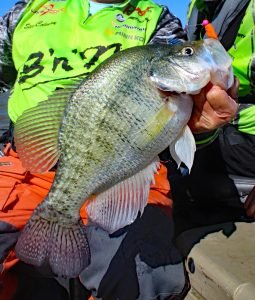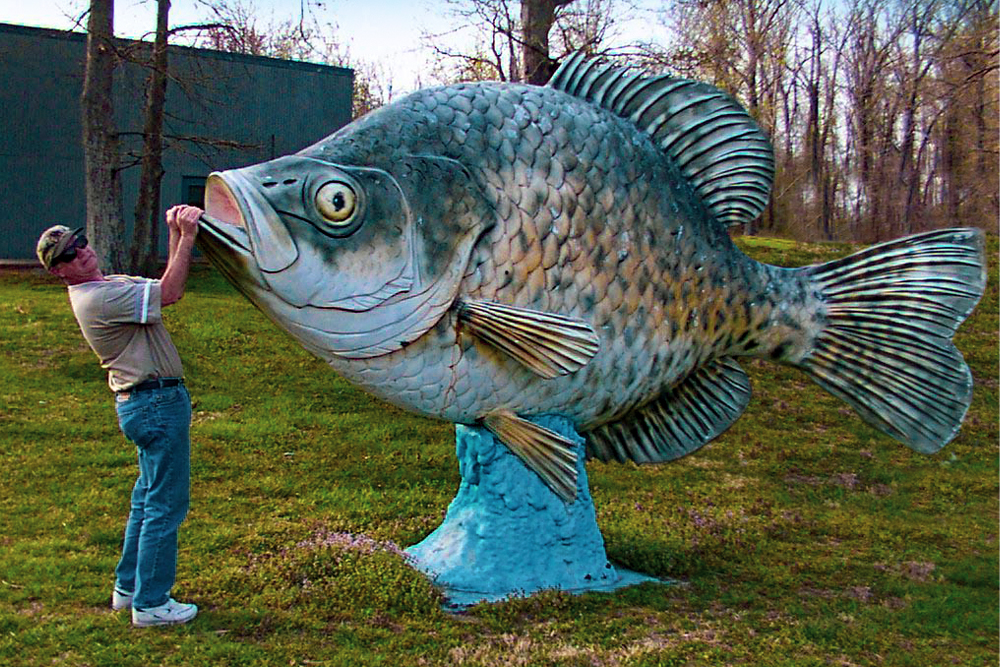Will larger size limits and smaller creel limits result in bigger crappie, or more crappie? Most fisheries biologists say, “Not necessarily.” We share your opinions from our CrappieNOW opinion survey. This giant crappie statue is located at Kirby Pocket on the well-known Reelfoot Lake in Tennessee.
And the Survey Says…
CrappieNOW Editor Richard Simms shares the results from an extensive opinion survey of your opinions on crappie size and creel limits in your state.
by Richard Simms
Mark Twain popularized the belief that, “There are three kinds of lies: lies, damned lies, and statistics.” Please remember that as we progress with this wrap-up of an extensive, unscientific survey conducted by CrappieNOW.
There, the disclosure is out of the way. Now on to the results. In March we surveyed CrappieNOW readers to gauge their feelings about crappie size limits and creel limits in their respective states. The key questions were (1) Do you believe your state should place a size limit on crappie LARGER than your existing size limit, and (2) Do you believe your state should place a creel limit on crappie SMALLER than your existing creel limit?

We received a total of 536 responses from 34 different states. The highest number of responses (115) came from Tennessee.
On the question regarding larger size limits, on a NATIONAL basis 249 (46 percent) said “No” their state should not have a larger size limit, while 207 (39 percent) said “Yes,” they felt their state should have a larger size limit. Fifteen percent (78) were undecided.
On the question regarding smaller creel limits, again on a NATIONAL basis 302 (56 percent) said “No” they did not want a smaller creel limit while 161 (30 percent) said “Yes,” they would like to see a smaller creel limit. Fourteen percent (73) were undecided.
Review the survey from your state here: CrappieNOW Crappie Size/Creel Limit Opinion Survey
CLICK HERE CLICK HERE
to view online to download
While interesting, the results on a national basis do not mean a lot. Regulations and fisheries simply vary too much to put stock in those results, other than to see where you fall among your cohorts across the country. We reached out to a few state biologists to get a better picture.
TENNESSEE
Again, we had the highest number of responses (115) from Tennessee. The statewide size limit on crappie there is a 10-inch minimum (with a couple of small local exceptions). The creel limit varies from 15 per person per day in East Tennessee to 20 or more in various waters in Middle and West Tennessee.

On a statewide basis, 67 percent of the respondents said “No,” they did not want to see a larger size limit while 25 percent said “Yes,” they would like to see a larger size limit. The remainder were undecided.
Pat Black, the Statewide Reservoir Program biologist for the Tennessee Wildlife Resources Agency said, “When crappie are protected from harvest through increased minimum size limits, a portion of fish that could be harvested and utilized by anglers are lost through natural processes. The 10-inch minimum size limit represents a good balance between protecting smaller fish from harvest so anglers can catch larger (1/2 lb. and greater) crappie and allowing fish to be harvested before they die from natural mortality.”
TWRA’s East Tennessee Reservoir Fisheries Biologist Mike Jolley said, “On average it takes a crappie in most (Tennessee) reservoirs three years to achieve the 10-inch size limit. Many anglers want to compare the increased minimum length limit regulations (12 inches) in north Mississippi reservoirs which do not compare to Tennessee. The crappie in these Mississippi reservoirs have much faster growth rates than we realize in Tennessee.”
The majority of Tennessee anglers (59 percent) were happy with the existing creel limits in their respective part of the state.
ALABAMA
The opinions were slightly different in Alabama where the statewide size limit on crappie is 9-inches. In Alabama the majority of survey respondents (53 percent) said, “Yes,” they would like to see a larger size limit (39 percent) said “No,” while the rest were undecided.
Damon Lee Abernethy, Assistant Chief of Fisheries for Alabama Wildlife & Freshwater Fisheries said, “The angler responses you received are not surprising. Many anglers believe raising the minimum length limits or reducing the bag limit will improve any fishery, no matter the circumstances. This is not the case, particularly with species that have high mortality rates, like crappie.”
Abernathy says the 9-inch minimum in Alabama protects crappie through their first spawn and says he doesn’t anticipate any immediate need to change.
“When crappie are protected from harvest through increased minimum size limits, a portion of fish that could be harvested and utilized by anglers are lost through natural processes.” ~ Pat Black, Tennessee Wildlife Resources Agency Statewide Reservoir Biologist
“In most cases, changes are not warranted, primarily due to the high natural mortality rates of crappie,” he said. “In other words, far more fish are dying of natural causes than are being harvested by anglers. Imposing harvest restrictions that are too conservative deprives anglers of the opportunity to harvest fish before they die of natural causes.”
Like Jolley he believes Alabama crappie anglers may be influenced by the quality crappie and large size limits in many North Mississippi reservoirs.
“Lakes with huge crappie, like Grenada in Mississippi, are not that way because of the 12-inch size limit,” he said. “Big crappie exist there naturally. The 12-inch minimum size limit should be thought of as an insurance policy designed to keep it that way.”
The well-known Weiss Lake in North Alabama does have a larger size limit (10-inches). Abernathy said the difference there versus the statewide limit really isn’t based upon the biology.
“The biological characteristics of the crappie fishery at Weiss really aren’t much different than in many other Alabama reservoirs,” said Abernathy. “Weiss is unique because it has been intensively promoted as a world-class crappie fishery and has expansive shallow water habitat where crappie can be easily located and caught by anglers. In a strict biological sense, there are a number of other reservoirs in Alabama that have better crappie ‘stat sheets’ than Weiss; however, due to their habitat characteristics, crappie are not as easy for the average angler to locate and catch.”
MINNESOTA
Moving north we generally received far fewer responses from the states where walleye is king.
Only eight people responded from Minnesota, however Jeff Reed, Fisheries Research Scientist with the Minnesota Department of Natural Resources said that according to their surveys, panfish (crappie and bluegill combined) are nearly as popular as walleye.
While there are exceptions on a limited number of lakes, there is a statewide creel limit of ten crappie per day in the Land of 10,000 Lakes and no size limit. Half of the eight respondents felt there should be a size limit on crappie and a small majority felt there should be a smaller creel limit.
Reed said, “We also do frequent surveys and generally avid anglers (such as the ones who respond to surveys) are more willing to forego bigger bag limits. The survey pretty well fits with what we would expect.”
Reed says obviously you cannot compare crappie growth rates in Minnesota to southern lakes.
“Generally, we are a year or two behind southern systems. Our crappie spawning age is closer to four or five years of age. A 3-year-old crappie (here) is generally 7-inches long.”
A few lakes which exhibit better growth rates or production do have more restrictive limits.
“We generally give our regional biologists three options. They can drop to a 5-fish creel limit, go to a 10-inch minimum size limit or a combination. We probably only have a two dozen lakes (out the 10,000 in the state) where we do that.”
MISSISSIPPI
With 2-to-3 pound crappie seemingly common from several North Mississippi reservoirs, there is understandably great interest. For that reason, we were somewhat surprised we didn’t hear from more Magnolia State anglers in the survey. There were 20 Mississippi respondents in our survey.

While there is no statewide size limit in Mississippi and a creel limit of 30, several North Mississippi reservoirs such as Sardis, Grenada, Enid and Arkabutla have a creel limit of 15 crappie with a 12-inch-minimum size limit.
In our survey 15 respondents (75 percent) said, “No,” there should not be a larger size limit. Only three respondents said, “Yes,” there should be a larger size limit while two were undecided.
Other than the highly-productive north Mississippi reservoirs, there is no statewide creel limit.
Again, fifteen people (75 percent said, “No,” to a smaller creel limit. Three said, “Yes,” there should be a smaller creel limit and two were undecided.
Larry Pugh, the Fisheries Bureau Director of the Mississippi Department of Wildlife, Fisheries, and Parks (MDWFP) said they have opted for no statewide size limit because, “Crappie populations are very different across Mississippi with respect to things like growth rates, reproduction, recruitment, and natural mortality. Crappie reproduction can be very ‘cyclic,’ producing strong year classes every 3-to-5 years. With the differences in biology all over the state, we choose to manage crappie on a lake-specific basis. We also try to keep the regulations simple and easy to understand.”
Pugh added, “A statewide size limit would actually cause crappie to stunt, or become crowded, in lakes where growth rates are already slow. In some cases, crappie would die of natural mortality before they would be big enough to be legally harvested.”
He says there is a significant difference in growth rates across the state.
“Yes, there is,” he said. “We have growth rate data from all over the state, and the fastest growth rates are at the (most productive reservoirs) Our goal with the 11 and 12-inch minimums is to allow crappie to spawn at least once, preferably twice, before they are vulnerable to being harvested. Crappie anglers do not practice catch-and-release. If the fish is legal, it’s kept. Also keep in mind that effort, or fishing pressure, on those lakes has increased substantially over the last 20 years. In response, we’ve tried to continue to meet angler expectations, thus enacting some pretty aggressive crappie regulations.”
Pugh summed it all up saying, “We’ve come a long way in crappie management in Mississippi. When I first started fishing, the daily bag limit was 50 per day. Now we have minimum length limits; pole limits; boat limits; and reduced bag limits on lakes where these tools are needed. And crappie fishing has changed. It’s year around now; trolling is as popular as ever; crappie tournaments continue to grow; and electronics have advanced so far so fast that it’s almost like video-game fishing.”
Tennessee biologist Pat Black pointed out that, “I’m somewhat guarded in forming conclusions based on a non-scientific opinion poll.”
Those are wise words. This survey is by no means meant to be a final or most accurate word on crappie management and regulations. Perhaps, however, you might be surprised a lot of people feel differently than you – or reinforced to learn that you are in the majority.
Just remember what fisheries biologists know all too well, “You can please some of the people all of the time, you can please all of the people some of the time, but you can never please all of the people all of the time.”
Review the survey from your state here: CrappieNOW Crappie Size/Creel Limit Opinion Survey
CLICK HERE to view online CLICK HERE to download
(Capt. Richard Simms, CrappieNOW Editor, has a degree in Wildlife/Fisheries Management and began his career in conservation as a game warden for the Tennessee Wildlife Resources Agency before becoming a wildlife photographer, public relations officer and then a professional journalist. He has a book in print called, “An Outdoor State of Mind.” Capt. Simms created Scenic City Fishing Charters in 2006, which now features six guides specializing in bass, catfish and crappie.)



